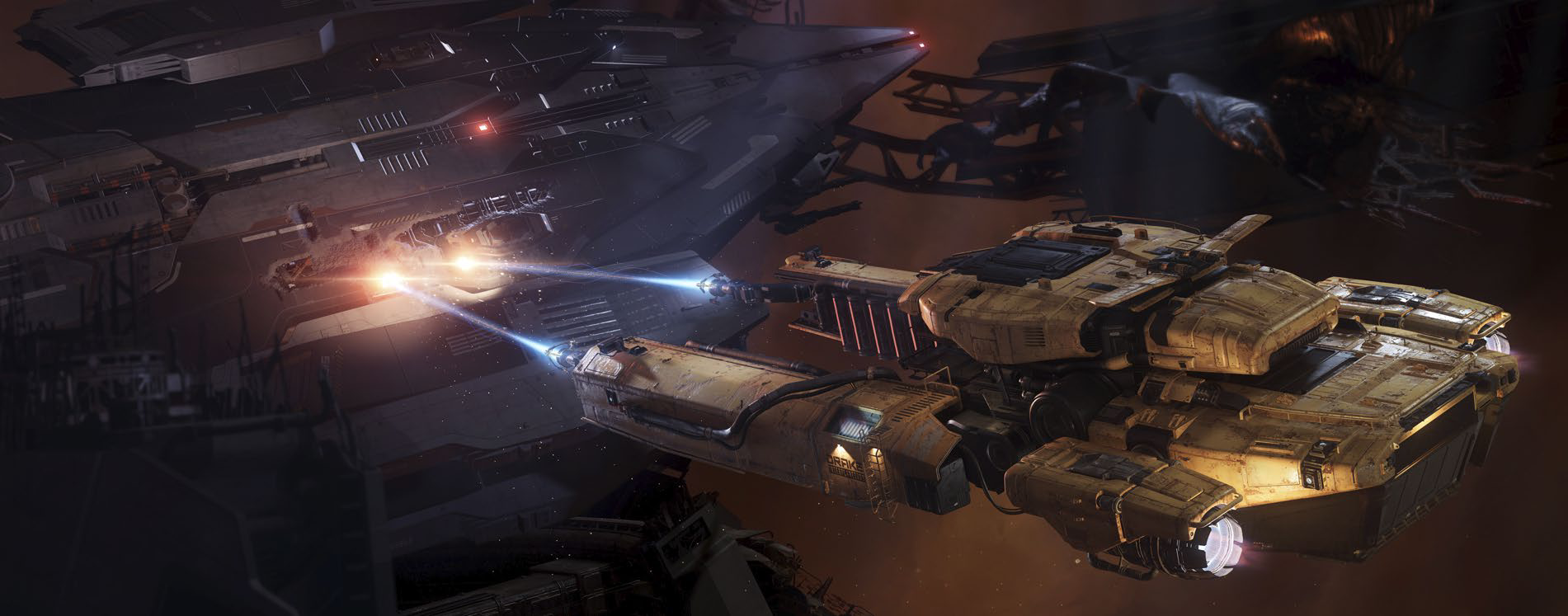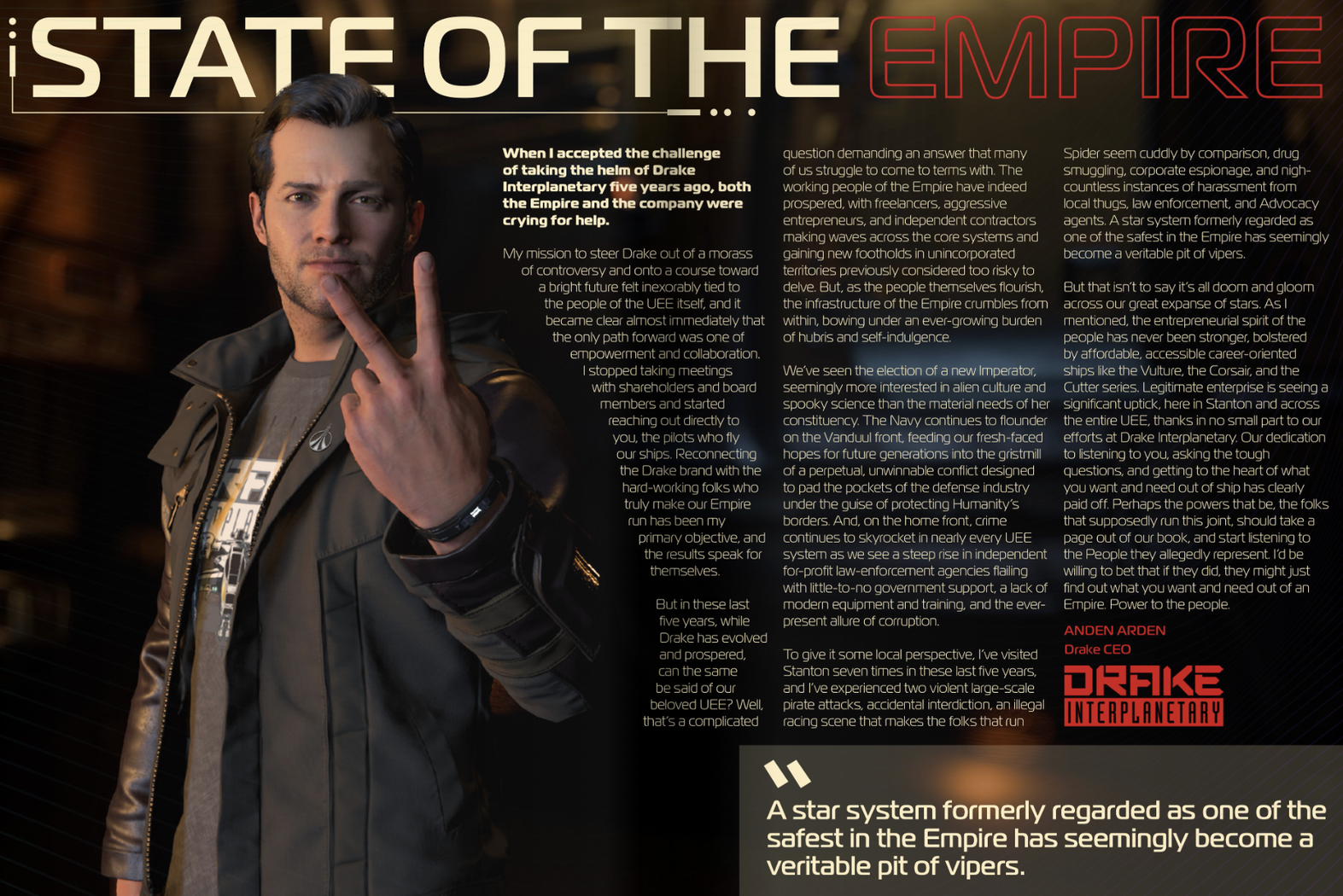
Drake Interplanetary - Complete History
Every civilization needs its heroes. Noble explorers, brave soldiers, visionary scientists. The United Empire of Earth has all those things. But what it really needed was a company mad enough to ask, “What if a gunship could also be a caravan?”
Enter Drake Interplanetary, the ship manufacturer that decided the best way to help frontier colonists survive was to arm them like small nations and let chaos sort itself out.
For over a century, Drake has been the poster child for questionable engineering brilliance. They build ships that are affordable, versatile, and, depending on who you ask, either the savior of the everyman or the preferred ride of pirates who think laws are just mild suggestions.
So how did this rough-and-ready manufacturer go from being rejected by the Navy to becoming one of the most beloved and controversial names in space? Grab a mug of synth-coffee and prepare yourself, because this is the full history of Drake Interplanetary, told with equal parts admiration and disbelief.

The World That Needed a Drake
In the mid-29th century, the UEE was in trouble. The Navy was broke, the ships were ancient, and the frontier worlds were so neglected that pirates were practically running the neighborhood watch.
To fix this, the brass dreamed up something called Home Defense Squadrons. These were local militias equipped and trained by the Navy, a brilliant idea in theory except they didn’t have enough ships to hand out.
So, they put out a tender for a new kind of craft: cheap, modular, easy to fix, and ideally able to blow something up without bankrupting the pilot.
Two companies applied. Aegis Dynamics, the Navy’s old favorite, and a team of upstart engineers led by a young Terran called Jan Dredge, who looked at the brief and said, “We can build that and make it comfortable enough to sleep in.”
Their ship was the AS-1 Cutlass, a sort of everything-machine that could fight, haul cargo, and probably double as a camper van if you didn’t mind the smell of missile fuel. It was tough, spacious, and designed for life at the edge of civilization.
Naturally, the Navy hated it.
They chose Aegis instead, leaving the Cutlass team with a brilliant ship and absolutely no customers. But rather than give up, Dredge and her crew did something the Navy never would. They went rogue.

The Birth of a Legend: Drake Interplanetary
In a defiant middle finger to bureaucracy, Jan Dredge and her team incorporated as Drake Interplanetary. The name wasn’t tied to anyone in particular, it just sounded like something you could trust to sell you a ship and then vanish into an asteroid belt.
They set up shop in the Magnus system, a place so lawless that even the UEE had given up trying to govern it. The old naval shipyards there were abandoned, dusty, and full of half-functional equipment. Drake saw an opportunity: free real estate, no regulators, and plenty of locals who didn’t ask questions.
From this derelict wasteland, the first Cutlass Black rolled off the line. It became an instant hit with militia pilots, frontier settlers, and anyone whose day job involved shooting back.
The Cutlass was affordable, modular, and sturdy enough to shrug off both micrometeorites and moral ambiguity. It was everything the average citizen needed to survive beyond the core worlds.
Unfortunately, it was also everything a pirate needed to make a living.

The Outlaw’s Ride
The same features that made the Cutlass beloved by colonists made it irresistible to the less reputable crowd. Within a decade, Drake’s ships became a common sight in police reports and bounty hunter briefings.
Drake’s PR department, which at the time consisted of one very tired accountant, tried to fix the image problem by releasing a new variant, the Cutlass Blue. It was a police-issue model with holding cells, non-lethal weaponry, and flashy red-and-blue lights.
It helped, sort of. Law enforcement liked it, but so did the criminals, who found the cells convenient for storing spare loot.
Still, the Blue proved that Drake could pivot. And if the Navy wouldn’t buy their ships, the public would. Soon, Drake was churning out variations faster than the UEE could ban them.

The Big Guns: The Caterpillar and the Rise of the Cargo King
While Jan Dredge’s engineers celebrated their success, she was already thinking bigger, literally. Inspired by the booming cargo market, Drake unveiled the Caterpillar, a massive modular freighter that looked like a shipping container mated with a sledgehammer.

At 111 meters long, the Caterpillar was a hauler, mobile base, and interstellar Lego set all in one. Its detachable command module could fly independently, and its modular bays could be swapped out for cargo, vehicles, or whatever questionable contraband you happened to be moving that week.
Critics said it looked outdated. The frontier said it looked perfect. Once again, Drake’s mix of affordability and utility won the day.
But with success came scrutiny, and then came scandal.

Bent Cutlass and the Red Redemption
In 2875, a sensational holovid documentary titled “Bent Cutlass” accused Drake of ignoring background checks and selling ships to criminals. It didn’t help that one of those deals allegedly ended with 122 dead in a raid.
Drake’s solution was simple. Build a hospital ship.

The Cutlass Red was born, a fully equipped ambulance variant complete with med-beds, scanners, and an interior so sterile it probably made pirates uncomfortable. Its initial ad campaign, featuring a TV doctor talking about scanner arrays, was unintentionally hilarious.
Then fate intervened. A tragic accident in the Corel system turned a fleet of Cutlass Reds into heroes overnight, rescuing hundreds of survivors when no other medical ships could reach them.
Overnight, the laughingstock became a lifesaver. Drake’s reputation, for once, was shining.

Speed Demons and Flying Bikes
Having conquered the stars, Drake decided to tackle a new challenge, the ground.
The result was the Dragonfly, a two-seater grav-bike that could fit inside a Cutlass or Caterpillar and make any pilot feel like a space cowboy. It was fast, loud, and about as safe as juggling plasma grenades, which of course made it wildly popular.
Even the Xi’an were impressed. They liked the concept so much they made their own version, the Nox. Yes, an alien civilization with centuries of anti-gravity mastery looked at Drake’s dangerous toy and said, “We’ll take two.”
That’s Drake in a nutshell, so reckless it inspires other species.

The Buccaneer: Because Subtlety Is for Cowards
By the late 2880s, tensions were rising along the Vanduul border. Citizens were nervous, pirates were thriving, and the Navy was still polishing its excuses.
So, Drake built the Buccaneer, a medium fighter designed to make up for the Navy’s absence through sheer overkill. It was fast, bristling with guns, and about as subtle as a sledgehammer in a crystal shop.
Drake’s marketing promised that the Buccaneer was “for those who defend themselves, not those who wait to be saved.” Translation, the Navy won’t help you, but we will, for a modest fee.
The Buccaneer sold like antimatter hotcakes. The frontier finally had a fighter that didn’t need a government contract to be effective.

Salvage, Scandal, and the Vulture’s Rise
In 2895, a UEE freighter called the Empire Slipper disappeared into a radiation belt, taking with it a cargo hold full of valuables and one very confused insurance company.
Drake saw opportunity, and publicity. They cobbled together a Frankenstein prototype from an old Cutlass frame, nicknamed VT3, and sent it to recover the wreck. Against all odds, it worked.

The mission was a triumph, until Drake got caught copying the flight data for “analysis.” Legal headaches followed, but the stunt proved the concept.
Decades later, that concept became the Vulture, a single-pilot salvage ship that let anyone try their hand at space treasure hunting. It was simple, rugged, and cheap, the Drake trifecta.
Soon the Vulture was everywhere, cleaning up battlefields and making a tidy profit for its captains. Even the Navy started buying them, though they never admitted it publicly.

Drake for the People: The Cutter and the Everyman
As the 30th century dawned, Drake realized they’d conquered almost every niche except one, the beginner pilot.
Enter the Cutter, a compact, affordable ship designed for people who couldn’t afford anything else but still wanted to look like smugglers. It was roomy, reliable, and had just enough firepower to make you overconfident.

Frontier settlers loved it. It could haul small vehicles, stay in space for weeks, and didn’t explode unless you really deserved it. The Cutter became the spiritual successor to the Cutlass, the gateway ship into Drake’s ecosystem of chaos.

A Change in the Cockpit
By 2947, founder Jan Dredge had built an empire and a reputation for saying things that made shareholders sweat. After a leaked interview where she joked about selling ships to pirates, public outrage forced her to step down.
Her replacement, Anden Arden, arrived with a plan to rehabilitate Drake’s image without killing its soul. He promised to focus less on combat and more on support and exploration, and then immediately announced a ship so large it needed its own zip code.

The Kraken: A Flying Spaceport for the Bold and the Reckless
The Kraken wasn’t a ship, it was a statement. Two hangars, six landing pads, room for a small town, and enough cargo space to hide several small moons. It was marketed as a “multi-role carrier for independent pilots,” which is corporate speak for “You can finally own your own aircraft carrier.”

It came in two versions, the standard Kraken, and the Privateer, a marketplace variant designed in collaboration with the infamous custom shipwright Cousin Crow, a reformed criminal turned engineer who could make a Starliner look like a nightclub.

The Privateer combined Banu market design with Drake’s utilitarian charm, resulting in a ship that looked equal parts battle carrier and floating bazaar. It was a masterpiece of madness, and somehow, it worked.

Drake vs. the Navy: DefenseCon and the Corsair
For years, the Navy snubbed Drake at its Invictus ship shows, claiming the company’s products were “unsuitable for formal display.” Translation, you make pirate ships.
Drake’s response was pure rebellion. They launched DefenseCon, their own event, right next door to Invictus, complete with banners reading “When the Fleet Moves On, Who Defends You?”

And there, they unveiled their next big hit, the Corsair, an exploration ship with more guns than some destroyers. It was roomy, rugged, and heavily armed, because Drake knows that “exploration” often means “someone’s shooting at you.”
It outsold its competitors instantly. Drake had once again turned a snub into a triumph.

The Modern Era: Forklifts, Variants, and the Ironclad
Never a company to slow down, Drake kept expanding. They built the Cutlass Steel, a troop transport that turned their classic design into a dropship with door guns and jump seats.
Then came the Mule, a six-wheeled forklift for loading cargo, essentially a frontier shopping cart with attitude.

After that, they revamped the Cutter line with the Rambler and Scout variants, one for long journeys, one for scouting and combat, each with more sensors, storage, and swagger.
And finally, they unveiled the Ironclad, a 120-meter super-hauler that looked like someone weaponized a warehouse. With 1,500 SCU of cargo space, a detachable command module, and an “Assault” version loaded with turrets and troop seats, it is the ultimate expression of Drake’s philosophy, “Why build one ship when you can build a small empire?”

Conclusion: The Duality of Drake
Drake Interplanetary is a contradiction wrapped in durasteel. It is a company that empowers the working class while quietly selling to outlaws. It champions freedom while building ships perfect for running from the law.
But whether you see them as heroes or hustlers, one thing is undeniable. Drake ships make the verse more interesting. They embody humanity’s restless, rebellious spirit, the refusal to wait for permission before taking off.
Every ship they make tells the same story, a little rough around the edges, wildly over-armed, and absolutely impossible not to love.
And that, perhaps, is Drake’s greatest achievement, proving that you don’t need approval from the UEE to build a legend. You just need a big engine, a few guns, and the audacity to fly straight into the void and call it home.































